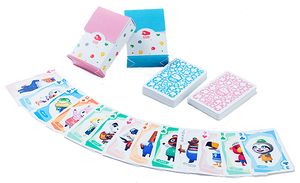Playing cards

| |
| Playing cards | |
| Designer | various |
|---|---|
| Manufacturer | various |
| Released | 9th century - present |
| Added to Museum |
See the playing cards category |
Playing cards are numbered cards used to gamble or play games of skill or chance.
Spanish-style playing cards
Spanish-style playing cards, usually known globally simply as the Spanish deck (baraja española), are playing cards that contain the Spanish suits of bastos (clubs), copas (cups), oros (gold coins), and espadas (swords).
They typically come in 48-card sets with two Jokers, with numbered cards in each suit from 1 to 9, and the royal cards escudero (knave or jack), caballo (horse carrying a knight), and rey (king) in each set as well.
40-card sets with two Jokers are also popular. These cards are identical to the 48-card set, except the numbered cards 8 and 9 are removed.
Playing cards arrived in Europe from Egypt in approximately 1370. The Spanish suit pattern was derived from Italian suits in approximately 1390.
French-style playing cards
French-style playing cards (jeu de cartes), also known in Japan as trump (トランプ), are playing cards that contain the French suits of trèfles (clovers or clubs), carreaux (tiles or diamonds), cœurs (hearts), and piques (pikes or spades).
They typically come in 52-card sets, with numbered cards in each suit from 2 to 10, and the royal cards valet (knave or jack), dame (lady or queen), and roi (king) in each set as well. The remaining card in each suit is an ace, which can have a point value of 1 or 14.
32-card sets are also popular in France. These cards are identical to the 52-card set, except the cards from 2 to 6 are removed, and cards with the numerical number 1 are stand-ins for the aces.
There are also 54-card sets which contain 2 joker cards, which were originally added as the bowers in the card game Euchre.
The French suit pattern was derived from German suits in approximately 1480.
Karuta
Karuta (かるた), named after the Portuguese "carta", are playing cards that originated in Japan in the 17th century. They have their distinctive image-based design due to the ban on Western-style playing cards instituted by Japan in that era.
In 1549, missionary Francis Xavier landed in Japan and the crew of his ship had carried a set of 48 Portuguese Hombre playing cards from Europe. The cards became in Japan, however after the country banned contact with the West in 1633, Western-style playing cards were banned as well.
A number of playing cards were developed in Japan to try to circumvent the ban, but the government banned each iteration due to its association with gambling. Eventually, card games with images instead of numbers were developed to get around these anti-gambling laws, and by the late 18th century, the first Hanufuda cards were developed. By the late 19th century, laws against Hanufuda and other image-based cards were relaxed, as their potential use in gambling was seen to be lessened due to a lack of an obvious numbering system that was present in Western-style playing cards.
Hanafuda
Hanafuda (花札, "flower cards"), are playing cards that originated in Japan in the late 18th century. They have their distinctive image-based design due to the ban on Western-style playing cards instituted by Japan in that era.
Nintendo
Nintendo Koppai (任天堂骨牌, "Nintendo Cards") was founded by Fusajiro Yamauchi on September 3, 1889, following the relaxation of laws against playing cards in Japan. The company was founded in Kyoto, in an area that was well known for Yakuza activity. Yamauchi used this to his advantage, originally producing handmade Hanafuda playing cards. Nintendo's Hanafuda cards soon began to be used in Yakuza gambling parlors.
When demand began to overwhelm his ability to produce the handmade cards on his own, Yamauchi hired a small team to help him create the cards. His cards had become so popular that by the early 20th century, he opened up another card shop in Osaka, Japan.